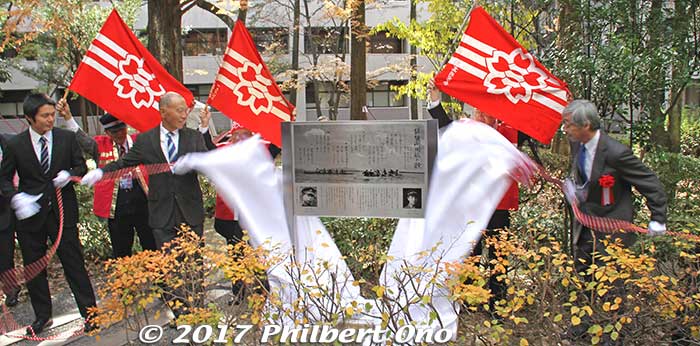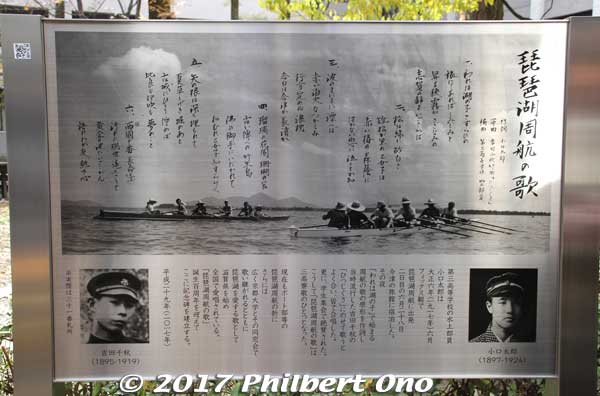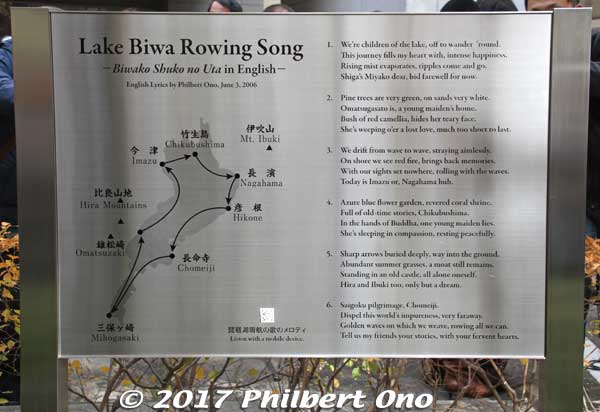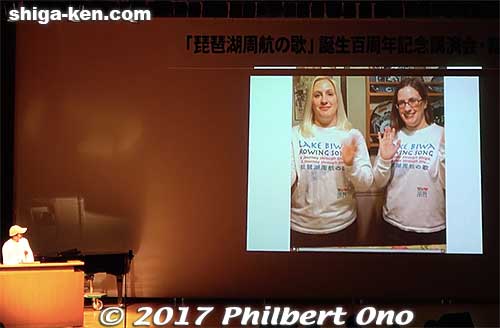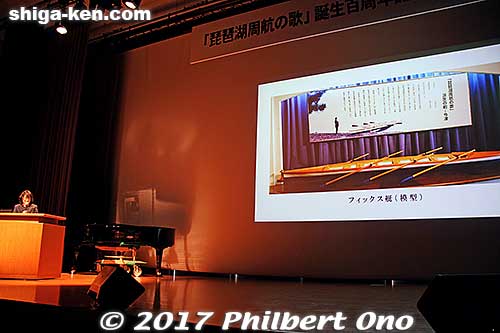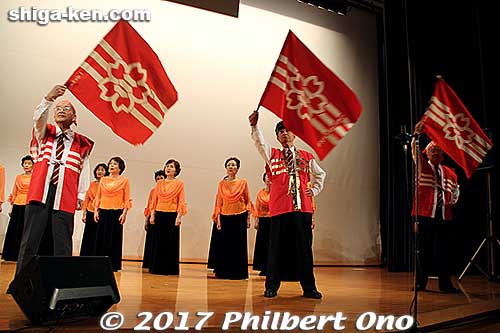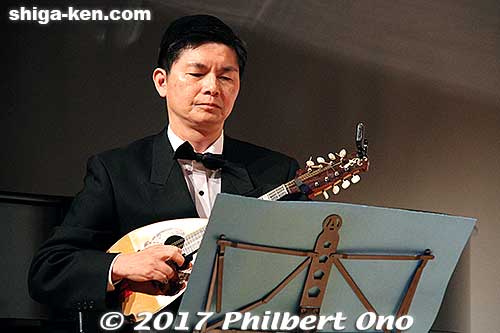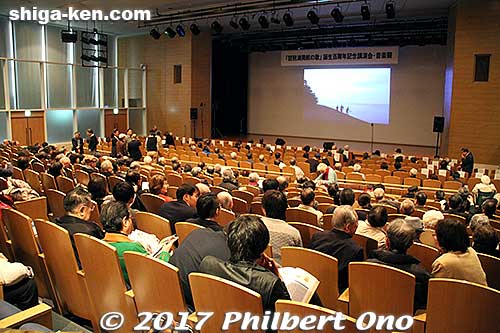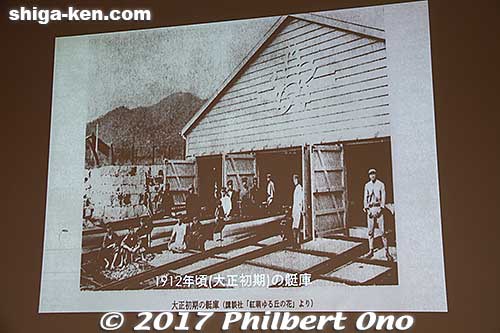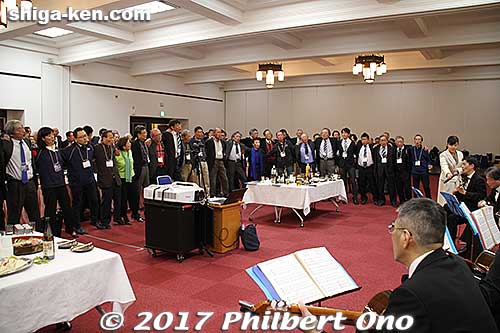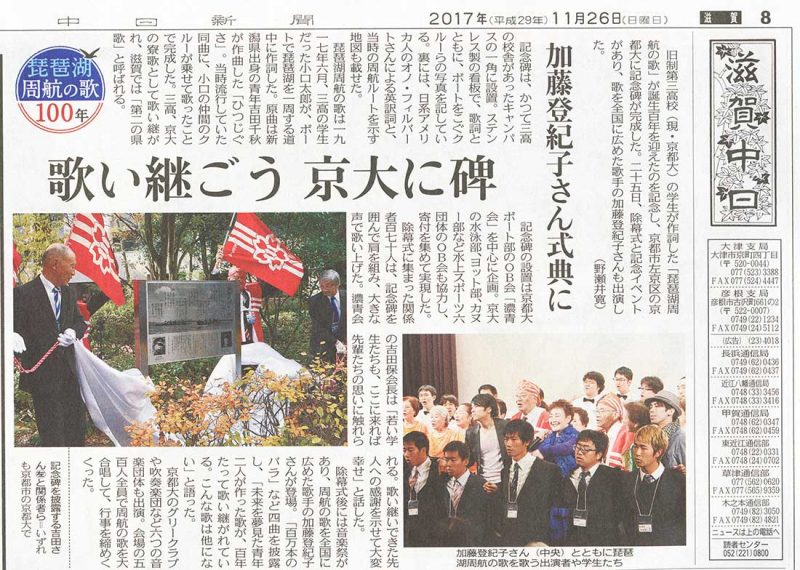京都大学「琵琶湖周航の歌」誕生百周年記念事業の報告
After the epic 100th anniversary celebration of Biwako Shuko no Uta in Shiga with a Lake Biwa rowing trip and concert in June 2017, it was Kyoto University’s turn to celebrate. On November 25, 2017, they unveiled a new song monument on campus and held a lecture session, music festival, and party. It was an all-day affair from 11:00 a.m. to 7:00 p.m. coinciding with the university’s annual school festival called “November Festival.”
Biwako Shuko no Uta (Lake Biwa Rowing Song) was created in June 1917 by rowing club members (especially Oguchi Taro) at an old elite university called Daisan Koto Gakko (No. 3 High School, nicknamed “Daisanko” or “Sanko” 三高) which merged with Kyoto University in 1949. Kyoto University has since adopted the legacy of Sanko by absorbing the Sanko campus (now the Yoshida-South Campus right across from the Main Campus), the rowing club, and adopting Biwako Shuko no Uta as one of the university’s official songs.
The Kyoto University Rowing Club (KURC) has a very active and dedicated alumni association called Noseikai (濃青会), which means “Dark Blue Association,” named after the rowing club’s official color of dark blue. (Their oar blades are dark blue.) This association spearheaded the planning and execution of the university’s celebration of the song’s 100th anniversary and also greatly helped with Shiga’s 100th anniversary song celebration in June 2017 which included a four-day rowing excursion around Lake Biwa by KURC alumni. They also helped to raise funds to build a new song monument on campus. Much of the fund-raising was done by the university’s water sports clubs (rowing, yachting, canoeing, and swimming).
Video
I took photos and videos of Kyoto University’s celebration and compiled the highlights in a 66-min. video that includes English subtitles. The video includes excellent concert performances of Biwako Shuko no Uta and Lake Biwa Rowing Song by the Kyoto University Glee Club and Kyoto University Symphonic Band. There’s also flashback footage from the Lake Biwa rowing trip in June 2017.(京都大学「琵琶湖周航の歌」誕生百周年記念事業のダイジェスト版動画)
Video link: https://youtu.be/_b3WrfV0rMI
Quick Links(動画早送りリンク)
Song monument unveiling(記念碑除幕式): https://youtu.be/_b3WrfV0rMI?t=3m51s
Lecture (Iida Tadayoshi)(講演会): https://youtu.be/_b3WrfV0rMI?t=11m
Hitsuji-gusa (Glee Club): https://youtu.be/_b3WrfV0rMI?t=16m46s
Nara no Miyako (Glee Club): https://youtu.be/_b3WrfV0rMI?t=17m41s
Introduction of Okaya and Niigata guests: https://youtu.be/_b3WrfV0rMI?t=19m16s
Lecture (English version 英語版): https://youtu.be/_b3WrfV0rMI?t=22m21s
Thompsons’ message: https://youtu.be/_b3WrfV0rMI?t=27m41s
Lake Biwa Rowing Song (Glee Club): https://youtu.be/_b3WrfV0rMI?t=28m46s
Lecture (Murai Yoshiko 資料館): https://youtu.be/_b3WrfV0rMI?t=30m9s
Music festival(音楽祭): https://youtu.be/_b3WrfV0rMI?t=32m50s
Biwako Shuko no Uta (Symphonic Band): https://youtu.be/_b3WrfV0rMI?t=33m36s
Speeches (Kawazoe Shinsuke, Koshi Naomi, Hiraoka Shoshichiro): https://youtu.be/_b3WrfV0rMI?t=37m22s
Sanko Alumni and Himawari Choir: https://youtu.be/_b3WrfV0rMI?t=40m54s
Mandolin Guitar Ensemble Kaguya: https://youtu.be/_b3WrfV0rMI?t=48m23s
What Shall We Do With The Drunken Sailor (Glee Club): https://youtu.be/_b3WrfV0rMI?t=50m58s
Biwako Shuko no Uta (Glee Club): https://youtu.be/_b3WrfV0rMI?t=53m53s
Biwako Shuko no Uta audience finale: https://youtu.be/_b3WrfV0rMI?t=56m35s
Party(懇親会): https://youtu.be/_b3WrfV0rMI?t=1h2m26s
Acknowledgements: https://youtu.be/_b3WrfV0rMI?t=1h4m56s
If you don’t have time to watch the video, you can continue reading to see photos instead. Links to the respective video footage are also provided below.
New Biwako Shuko no Uta song monument at Kyoto University
京都大学の「琵琶湖周航の歌」記念碑
Kyoto University’s 100th anniversary celebration of Biwako Shuko no Uta started with the unveiling of a new song monument on the Yoshida-South Campus (the former Sanko campus) at 11:00 a.m. on November 25, 2017. (Video here.) This campus is right across the road from the main campus (and main gate). (See map and directions below.) Built to commemorate the song’s 100th anniversary, the new song monument is a beautiful, double-sided, stainless-steel panel with a brushed-metal finish.
The front side has the Japanese lyrics (all six verses) overlaid on a recent photo of Kyoto University Rowing Club members rowing on Lake Biwa. The uncredited calligraphy of the Japanese lyrics on the song monument was done by Ichihara Atsushi (市原 厚), a KURC alumnus who has been publishing a kiri-e calendar for the song every year since 1986 (sold at the Biwako Shuko no Uta Shiryokan song museum in Imazu). (Update: Sadly, Mr. Ichihara passed away in Oct. 2018 at age 83 and his 2019 calendar will be his last one.)
The lower part has a Japanese explanation about the song and a photo of Oguchi Taro (right) who wrote the lyrics and Yoshida Chiaki (left) whose melody was used for the song. This is my English translation of the explanation(記念碑の表面の解説の英訳):
Daisan Koto Gakko (No. 3 High School) rowing club member Oguchi Taro left in June 1917 (Taisho 6) on a fixed-seat boat to row around Lake Biwa. On the second day on June 28, they stayed at a ryokan in Imazu.
That evening, he composed a draft of a rowing song that started with “Ware wa Umi no ko” (We’re children of the lake). They sang it to the melody of Hitsuji-gusa (Water Lilies), a popular song at the time composed by Yoshida Chiaki. The melody matched the song well and they sang it together.
The song was well received at student gatherings. This is how Biwako Shuko no Uta became a college dormitory song of Sanko (Daisan Koto Gakko).
Today, the song continues to be sung by the university’s rowing club when they row around Lake Biwa and by many people at Kyoto University and class reunions.
Also, as a song expressing affection for Lake Biwa, the song is lovingly sung by people in Shiga Prefecture and across Japan.
To mark the 100th anniversary of Biwako Shuko no Uta, we built this monument here.
Heisei 29 (2017)
From the late 19th century, dormitories at Japan’s elite universities started a tradition of creating their own “dormitory songs” to be performed at their annual dormitory festivals. Dormitory boarders sang the song together at dormitory festivals and student gatherings. While most of these songs fell into obscurity, some dormitory songs like Biwako Shuko no Uta continue to be sung.
The rear side of the song monument shows a bilingual Lake Biwa map of the rowing route taken by Oguchi and his rowing mates in June 1917 and my Lake Biwa Rowing Song English lyrics (all six verses).
Members of the KURC alumni association (Noseikai) initially proposed building this song monument for the song’s 100th anniversary. There were already song monuments in Shiga and Okaya, Nagano Prefecture, but none at Kyoto University. So they thought the university should also have a monument.
The university agreed to have the song monument on campus, but it required the monument to also include English lyrics. At first, the alumni association wondered where they could obtain English lyrics, but they soon found my English version of the song. They contacted me in 2016 and asked for my permission to use my English lyrics. I said, “YES, YES!! Please do so!!” “You can use it for free! No charge!!” And so they did.
Kyoto University has been pushing to become more international and more attractive for international students. So they wanted a monument that international students could also understand. I was very impressed to hear this. A song monument in Japan with both Japanese and English lyrics must be extremely rare. I haven’t seen one until now.
The current Kyoto University President is Yamagiwa Juichi who speaks English. He has traveled the world to study primates and gorillas as a way to learn more about early humans and their evolution. So he’s very internationally oriented. Having someone at the top with an international outlook helps a lot.
I’m certainly very honored and delighted to see my English lyrics on a monument. Monuments are usually built to point out something (or someone) that is important. So monuments naturally attract people’s attention. It’s important for a monument to be easy to read and in a good location where people can see it. This new monument meets both of these conditions.
It was the Verse 1 song monument in Mihogasaki, Otsu that first piqued the interest of Iida Tadayoshi, the foremost song researcher (since 1974) who has written a few books about Biwako Shuko no Uta. And I also first learned about the song when I saw a statue of composer Oguchi Taro and a song monument in Okaya, Nagano Prefecture. So song monuments can be very worthy to have. I wonder if there’s any other song in Japan that has this many monuments for it in three prefectures.
I’m very hopeful that this new monument will pique the interest of both Japanese and non-Japanese students in the song and in Shiga. I believe the song’s story, background, melody, and vivid depiction of Shiga can fascinate any young mind. The monument also has a QR code that you can scan with your mobile device to access the rowing club’s official 100th song anniversary website where you can learn more about the song and watch song videos in both Japanese and English.
Map and directions to new song monument
Here’s a map of the exact location of the new song monument (and the other song monuments). Zoom in on Kyoto. From JR Kyoto Station, get out the Karasuma exit (Kyoto Tower side) and go to Bus Stop D2 to board bus No. 206 bound for Kitaoji Bus Terminal. Get off at Kyodai Seimon-mae (京大正門前). The ride takes about 35 min. The main campus will be across the street from the bus stop, and the entrance to the Yoshida-South Campus is across the road facing the main campus.
Lecture Session (記念講演会) (Video here)
After the unveiling of the song monument, we had lunch and moved to the Kyoto University Clock Tower Centennial Hall for an hour-long Lecture Session (including performances by the Kyoto University Glee Club) starting at 12:30 pm.
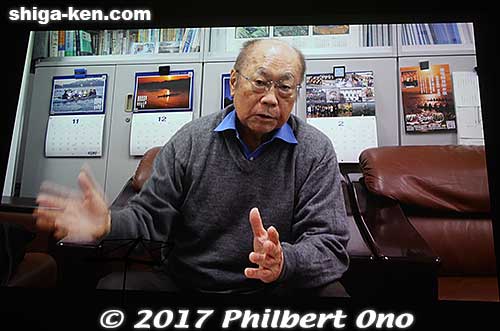
The main speaker was song researcher Iida Tadayoshi. He is the foremost authority on the song. A lot of what we know about the song and the composers is due to his research. He talked about how the song was created by Oguchi Taro and how the Hitsuji-gusa melody by Yoshida Chiaki was adapted to it.
Due to health reasons, Iida sensei was unable to appear in person so he appeared in a video lecture. Video here. After his lecture, the Kyoto University Glee Club sang Hitsuji-gusa (Verse 1) composed by Yoshida Chiaki and Nara no Miyako (Verse 1) which was the song whose melody Oguchi originally considered using for Biwako Shuko no Uta. Video here.
I was the second speaker, taking about 10 min. to mainly show slides of people who helped and encouraged me before and after I finished writing the English lyrics. Since Jamie and Megan Thompson (who sang Lake Biwa Rowing Song) could not make it to Japan in Nov., I showed a one-minute video message in Japanese from them. Video here.
After my talk, the Kyoto University Glee Club beautifully sang the first verse of Lake Biwa Rowing Song. (Video here.)
The third and last speaker was Murai Yoshiko, the director of the Biwako Shuko no Uta Shiryokan song museum in Imazu. She used slides to explain about the museum near JR Omi-Imazu Station and encouraged everyone to visit. Video here.
Music Festival (記念音楽祭) (Video here)
After a 30-min. break, the Music Festival (Ongakusai) started at 2:00 p.m. in the same Clock Tower Centennial Hall (capacity 500) as the Lecture Session. Part 1 had the Kyoto University Symphonic Band, Kyoto University Glee Club, Himawari Choir (from Otsu), and Mandolin Guitar Ensemble Kaguya perform or sing Biwako Shuko no Uta and a few other songs.
Part 2 featured a 40-min. talk show by singer Kato Tokiko. The finale had all the performers appear on stage to sing Biwako Shuko no Uta together with the entire audience. The finale was led by Kato Tokiko and the music festival ended at 4:30 pm.
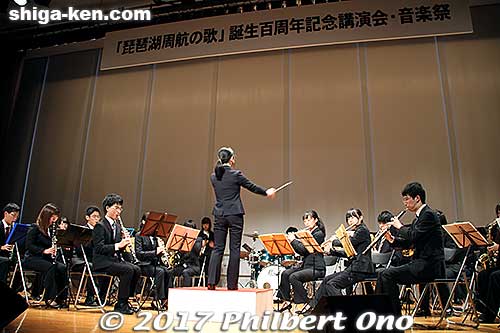
Short congratulatory speeches were also given by three dignitaries:
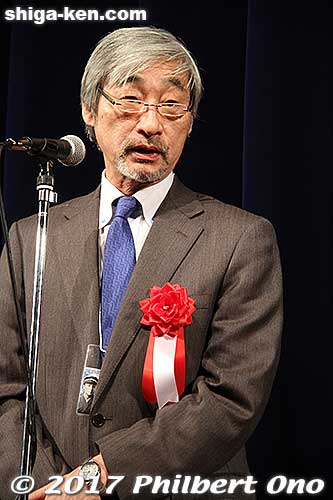
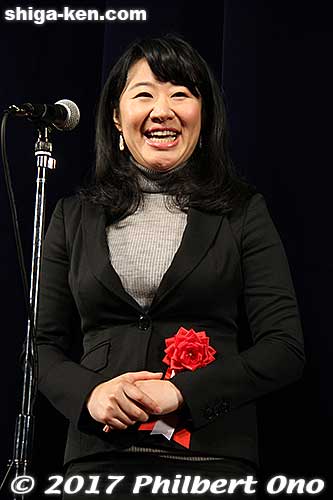
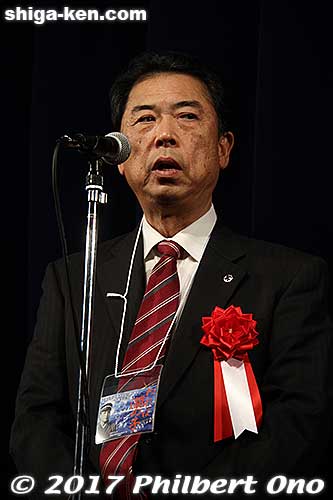
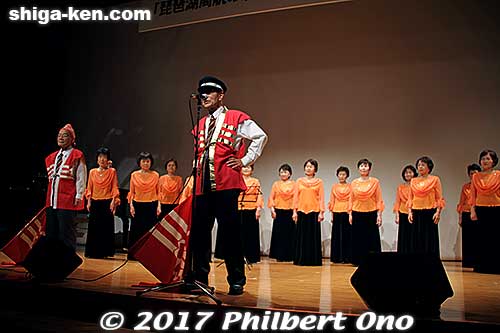
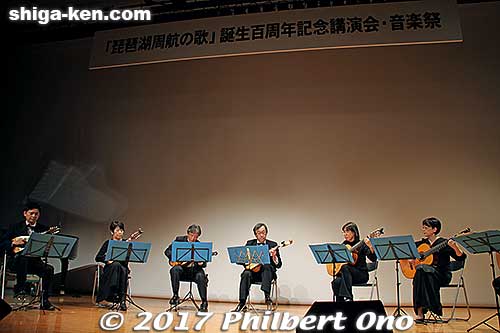


Party (懇親会) (Video here)
After the music festival, attendees had the option to attend the party from 5:00 pm to 7:00 pm on the 2nd floor of the Clock Tower Centennial Hall. This was when we could finally mix and socialize. It was nice meeting and talking with people from Oguchi Taro’s hometown and Yoshida Chiaki’s hometown and rowing club alumni. Very few women though.

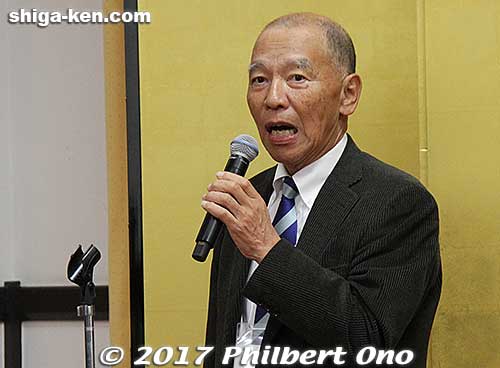
The celebrations of Biwako Shuko no Uta’s 100th anniversary in Shiga and Kyoto were quite spectacular. It has spread awareness of the song as a precious hometown asset. Shiga has so few famous hometown songs, and even its most famous one is in danger of being forgotten since it’s not really taught in schools.
Where I come from, there are many, many beloved Hawaiian songs (and dances) that continue to be sung for generations. I cannot imagine growing up in a place that lacks popular hometown songs. It shapes your identity and affinity with your hometown. It would be a major cultural loss if Shiga allowed Biwako Shuko no Uta to fall into obscurity. It is by far Shiga’s most nationally famous song.
It’s comforting to see more people singing the song in Japanese or English. They are posting on YouTube. Anyone is welcome to sing the song in Japanese or English. I still wish John Denver lived long enough to record it. His voice matches the song extremely well.
Thank you to everyone who made the 100th anniversary celebration a great success.
本当に素晴らしい記念事業でした。皆さんお疲れ様でした。
Related video:
Related links:
- About Lake Biwa Rowing Song
- 琵琶湖周航の歌 英語版 (in Japanese)
- Photos of Lake Biwa Rowing Song
- Song Monuments
- Oguchi Taro
- Yoshida Chiaki
感 謝
Acknowledgements
京都大学
山極 壽一 総長
川添 信介 理事・副学長
「琵琶湖周航の歌」誕生百周年記念事業実行委員会
京都大学ボート部
中村 佳正 京都大学ボート部長
京都大学ボート部 濃青会
吉田 保 京都大学ボート部濃青会会長
伊藤 七郎
旧制第三高等学校OB
小島 安紀子
尾城 徹雄
青野 正治
京都大学医学部ボート部・芝蘭会艇友会
京都大学ヨット部
京都大学カヌー部
京都大学水泳部・京泳会
ヨットクラブ神陵・京大神陵会
京都大学グリークラブ
京都大学吹奏楽団
その他の京都大学側の関係者・支援者
琵琶湖周航の歌資料館 全スタッフ(2004年以来)
澤田 浩(琵琶湖周航の歌資料館 元館長)
村井 佳子(琵琶湖周航の歌資料館 館長)
びわ湖高島観光協会
故 前田典夫(みちお)
琵琶湖周航の歌100周年記念事業実行委員会
嘉田 由紀子(代表)
加藤 登紀子
小坂 育子
北川 陽大(〜Lefa〜)
飯田 忠義
小口太郎顕彰碑等保存会(長野県岡谷市)
Naoko Nakamura
吉田ゆき (新潟)
ちあきの会
朗読劇団ムサシ(滋賀県高島市)
森本純一(代表)
中日新聞(滋賀版)
毎日新聞(滋賀版)
その他の報道陣
Jamie & Megan Thompson
日永 真梨子
菊井 了・近藤 ゆみ子(レイクリード)
Chikage Fujii(滋賀県湖南市)
その他の関係者・支援者・協力者・友人・親戚・ファン
小口太郎
吉田千秋
